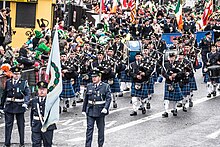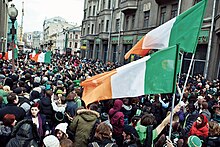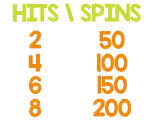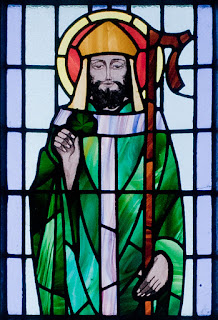Celebrations by region
Ireland

A St Patrick's Day parade in Dublin
Saint Patrick's feast day, as a kind of national day, was already being celebrated by the Irish in Europe in the ninth and tenth centuries. In later times, he became more and more widely seen as the patron of Ireland. Saint Patrick's feast day was finally placed on the universal liturgical calendar in the Catholic Church due to the influence of Waterford-born Franciscan scholar Luke Wadding in the early 1600s. Saint Patrick's Day thus became a holy day of obligation for Roman Catholics in Ireland. It is also a feast day in the Church of Ireland, which is part of the worldwide Anglican Communion. The church calendar avoids the observance of saints' feasts during certain solemnities, moving the saint's day to a time outside those periods. St Patrick's Day is occasionally affected by this requirement, when 17 March falls during Holy Week. This happened in 1940, when Saint Patrick's Day was observed on 3 April to avoid it coinciding with Palm Sunday, and again in 2008, where it was officially observed on 15 March. St Patrick's Day will not fall within Holy Week again until 2160. However, the popular festivities may still be held on 17 March or on a weekend near to the feast day.
In 1903, St Patrick's Day became an official public holiday in Ireland. This was thanks to the Bank Holiday (Ireland) Act 1903, an act of the United Kingdom Parliament introduced by Irish Member of Parliament James O'Mara. O'Mara later introduced the law which required that public houses be shut on 17 March, a provision that was later deemed unnecessary and was repealed in the 1970s.
The first St Patrick's Day parade in Ireland was held in Waterford in 1903. The week of St Patrick's Day 1903 had been declared Irish Language Week by the Gaelic League and in Waterford they opted to have a procession on Sunday 15 March. The procession comprised the Mayor and members of Waterford Corporation, the Trades Hall, the various trade unions and bands who included the 'Barrack St Band' and the 'Thomas Francis Meagher Band'. The parade began at the premises of the Gaelic League in George's St and finished in the Peoples Park, where the public were addressed by the Mayor and other dignitaries. On Tuesday 17 March, most Waterford businesses—including public houses—were closed and marching bands paraded as they had two days previously. The Waterford Trades Hall had been emphatic that the National Holiday be observed.
On St Patrick's Day 1916, the Irish Volunteers—an Irish nationalist paramilitary organisation—held parades throughout Ireland. The authorities recorded 38 St Patrick's Day parades, involving 6,000 marchers, almost half of whom were said to be armed. The following month, the Irish Volunteers launched the Easter Rising against British rule. This marked the beginning of the Irish revolutionary period and led to the Irish War of Independence and Civil War. During this time, St Patrick's Day celebrations in Ireland were muted, although the day was sometimes chosen to hold large political rallies. The celebrations remained low-key after the creation of the Irish Free State; the only state-organized observance was a military procession and trooping of the colours, and an Irish-language mass attended by government ministers. In 1927, the Irish Free State government banned the selling of alcohol on St Patrick's Day, although it remained legal in Northern Ireland. The ban was not repealed until 1961.
The first official, state-sponsored St Patrick's Day parade in Dublin took place in 1931. On three occasions, parades across the Republic of Ireland have been cancelled from taking place on St Patrick's Day, with all years involving health and safety reasons. In 2001, as a precaution to the foot-and-mouth outbreak, St Patrick's Day celebrations were postponed to Mayand in 2020 and 2021, as a consequence to the severity of the COVID-19 pandemic, the St Patrick's Day Parade was cancelled outright. Organisers of the St Patrick's Day Festival 2021 will instead host virtual events around Ireland on their SPF TV online channel.
In Northern Ireland, the celebration of St Patrick's Day was affected by sectarian divisions. A majority of the population were Protestant Ulster unionists who saw themselves as British, while a substantial minority were Catholic Irish nationalists who saw themselves as Irish. Although it was a public holiday, Northern Ireland's unionist government did not officially observe St Patrick's Day. During the conflict known as the Troubles (late 1960s–late 1990s), public St Patrick's Day celebrations were rare and tended to be associated with the Catholic community. In 1976, loyalists detonated a car bomb outside a pub crowded with Catholics celebrating St Patrick's Day in Dungannon; four civilians were killed and many injured. However, some Protestant unionists attempted to 're-claim' the festival, and in 1985 the Orange Order held its own St Patrick's Day parade. Since the end of the conflict in 1998 there have been cross-community St Patrick's Day parades in towns throughout Northern Ireland, which have attracted thousands of spectators.
In the mid-1990s the government of the Republic of Ireland began a campaign to use St Patrick's Day to showcase Ireland and its culture. The government set up a group called St Patrick's Festival, with the aims:
- To offer a national festival that ranks amongst all of the greatest celebrations in the world
- To create energy and excitement throughout Ireland via innovation, creativity, grassroots involvement, and marketing activity
- To provide the opportunity and motivation for people of Irish descent (and those who sometimes wish they were Irish) to attend and join in the imaginative and expressive celebrations
- To project, internationally, an accurate image of Ireland as a creative, professional and sophisticated
- country with wide appeal.
The first St Patrick's Festival was held on 17 March 1996. In 1997, it became a three-day event, and by 2000 it was a four-day event. By 2006, the festival was five days long; more than 675,000 people attended the 2009 parade. Overall 2009's five-day festival saw almost 1 million visitors, who took part in festivities that included concerts, outdoor theatre performances, and fireworks. The Skyfest which ran from 2006 to 2012 formed the centrepiece of the St Patrick's festival.
The topic of the 2004 St Patrick's Symposium was "Talking Irish", during which the nature of Irish identity, economic success, and the future were discussed. Since 1996, there has been a greater emphasis on celebrating and projecting a fluid and inclusive notion of "Irishness" rather than an identity based around traditional religious or ethnic allegiance. The week around St Patrick's Day usually involves Irish language speakers using more Irish during Seachtain na Gaeilge ("Irish Language Week").
Christian leaders in Ireland have expressed concern about the secularisation of St Patrick's Day. In The Word magazine's March 2007 issue, Fr Vincent Twomey wrote, "It is time to reclaim St Patrick's Day as a church festival". He questioned the need for "mindless alcohol-fuelled revelry" and concluded that "it is time to bring the piety and the fun together".
As well as Dublin, many other cities, towns, and villages in Ireland hold their own parades and festivals, including Cork, Belfast, Derry, Galway, Kilkenny, Limerick, and Waterford.[citation needed]
The biggest celebrations outside the cities are in Downpatrick, County Down, where Saint Patrick is said to be buried. The shortest St. Patrick's Day parade in the world formerly took place in Dripsey, County Cork. The parade lasted just 23.4 metres and traveled between the village's two pubs. The annual event began in 1999, but ceased after five years when one of the two pubs closed.
Elsewhere in Europe
England
In England, the British Royals traditionally present bowls of shamrock to members of the Irish Guards, a regiment in the British Army, following Queen Alexandra introducing the tradition in 1901. Since 2012 the Duchess of Cambridge has presented the bowls of shamrock to the Irish Guards. While female royals are often tasked with presenting the bowls of shamrock, male royals have also undertaking the role, such as King George VI in 1950 to mark the 50th anniversary of the formation of the Irish Guards, and in 2016 the Duke of Cambridge in place of his wife. Fresh Shamrocks are presented to the Irish Guards, regardless of where they are stationed, and are flown in from Ireland.
While some Saint Patrick's Day celebrations could be conducted openly in Britain pre 1960s, this would change following the commencement by the IRA's bombing campaign on mainland Britain and as a consequence this resulted in a suspicion of all things Irish and those who supported them which led to people of Irish descent wearing a sprig of shamrock on Saint Patrick's day in private or attending specific events. Today after many years following the Good Friday Agreement, people of Irish descent openly wear a sprig of shamrock to celebrate their Irishness.
Christian denominations in Great Britain observing his feast day include The Church of England and the Roman Catholic Church.
Birmingham holds the largest Saint Patrick's Day parade in Britain with a city centre parade over a two-mile (3 km) route through the city centre. The organisers describe it as the third biggest parade in the world after Dublin and New York.
London, since 2002, has had an annual Saint Patrick's Day parade which takes place on weekends around the 17th, usually in Trafalgar Square. In 2008 the water in the Trafalgar Square fountains was dyed green. In 2020 the Parade was cancelled due to the COVID-19 pandemic.
Liverpool has the highest proportion of residents with Irish ancestry of any English city. This has led to a long-standing celebration on St Patrick's Day in terms of music, cultural events and the parade.
Manchester hosts a two-week Irish festival in the weeks prior to Saint Patrick's Day. The festival includes an Irish Market based at the city's town hall which flies the Irish tricolour opposite the Union Flag, a large parade as well as a large number of cultural and learning events throughout the two-week period.
Malta
The first Saint Patrick's Day celebrations in Malta took place in the early 20th century by soldiers of the Royal Dublin Fusiliers who were stationed in Floriana. Celebrations were held in the Balzunetta area of the town, which contained a number of bars and was located close to the barracks. The Irish diaspora in Malta continued to celebrate the feast annually.
Today, Saint Patrick's Day is mainly celebrated in Spinola Bay and Paceville areas of St Julian's, although other celebrations still occur at Floriana and other locations. Thousands of Maltese attend the celebrations, "which are more associated with drinking beer than traditional Irish culture."
Norway
Norway has had a St. Patrick's Day parade in Oslo since 2000, first organized by Irish expatriates living in Norway, and partially coordinated with the Irish embassy in Oslo.
Russia

Moscow hosts an annual Saint Patrick's Day festival.
The first Saint Patrick's Day parade in Russia took place in 1992. Since 1999, there has been a yearly "Saint Patrick's Day" festival in Moscow and other Russian cities. The official part of the Moscow parade is a military-style parade and is held in collaboration with the Moscow government and the Irish embassy in Moscow. The unofficial parade is held by volunteers and resembles a carnival. In 2014, Moscow Irish Week was celebrated from 12 to 23 March, which includes Saint Patrick's Day on 17 March. Over 70 events celebrating Irish culture in Moscow, St Petersburg, Yekaterinburg, Voronezh, and Volgograd were sponsored by the Irish Embassy, the Moscow City Government, and other organisations.
In 2017, the Russian Orthodox Church added the feast day of Saint Patrick to its liturgical calendar, to be celebrated on 30 March [O.S. 17 March].
Bosnia and Herzegovina
Sarajevo, the capital city of Bosnia and Herzegovina has a large Irish expatriate community. The community established the Sarajevo Irish Festival in 2015, which is held for three days around and including Saint Patrick's Day. The festival organizes an annual a parade, hosts Irish theatre companies, screens Irish films and organizes concerts of Irish folk musicians. The festival has hosted numerous Irish artists, filmmakers, theatre directors and musicians such as Conor Horgan, Ailis Ni Riain, Dermot Dunne, Mick Moloney, Chloë Agnew and others.
Scotland
The Scottish town of Coatbridge, where the majority of the town's population are of Irish descent, also has a Saint Patrick's Day Festival which includes celebrations and parades in the town centre.
Glasgow has a considerably large Irish population; due, for the most part, to the Irish immigration during the 19th century. This immigration was the main cause in raising the population of Glasgow by over 100,000 people. Due to this large Irish population, there are many Irish-themed pubs and Irish interest groups who hold yearly celebrations on Saint Patrick's day in Glasgow. Glasgow has held a yearly Saint Patrick's Day parade and festival since 2007.
Switzerland
While Saint Patrick's Day in Switzerland is commonly celebrated on 17 March with festivities similar to those in neighbouring central European countries, it is not unusual for Swiss students to organise celebrations in their own living spaces on Saint Patrick's Eve. Most popular are usually those in Zurich's Kreis 4. Traditionally, guests also contribute with beverages and dress in green.
Lithuania
Although it is not a national holiday in Lithuania, the Vilnia River is dyed green every year on the Saint Patrick's Day in the capital Vilnius.
Asia
Japan
Saint Patrick's parades are now held in many locations across Japan. The first parade, in Tokyo, was organised by The Irish Network Japan (INJ) in 1992.
Korea
The Irish Association of Korea has celebrated Saint Patrick's Day since 1976 in Seoul, the capital city of South Korea. The place of the parade and festival has been moved from Itaewon and Daehangno to Cheonggyecheon.
Malaysia
In Malaysia, the St Patrick's Society of Selangor, founded in 1925, organises a yearly St Patrick's Ball, described as the biggest Saint Patrick's Day celebration in Asia. Guinness Anchor Berhad also organises 36 parties across the country in places like the Klang Valley, Penang, Johor Bahru, Malacca, Ipoh, Kuantan, Kota Kinabalu, Miri and Kuching.
Caribbean
Montserrat
The island of Montserrat is known as the "Emerald Island of the Caribbean" because of its founding by Irish refugees from Saint Kitts and Nevis. Montserrat is one of three places where Saint Patrick's Day is a public holiday, along with Ireland and the Canadian province of Newfoundland & Labrador. The holiday in Montserrat also commemorates a failed slave uprising that occurred on 17 March 1768.
International Space Station
Astronauts on board the International Space Station have celebrated the festival in different ways. Irish-American Catherine Coleman played a hundred-year-old flute belonging to Matt Molloy and a tin whistle belonging to Paddy Moloney, both members of the Irish music group The Chieftains, while floating weightless in the space station on Saint Patrick's Day in 2011. Her performance was later included in a track called "The Chieftains in Orbit" on the group's album, Voice of Ages.
Chris Hadfield took photographs of Ireland from Earth orbit, and a picture of himself wearing green clothing in the space station, and posted them online on Saint Patrick's Day in 2013. He also posted online a recording of himself singing "Danny Boy" in space.
North America
Canada

Montreal hosts one of the longest-running and largest Saint Patrick's Day parades in North America
One of the longest-running and largest Saint Patrick's Day (French: le jour de la Saint-Patrick) parades in North America occurs each year in Montreal, whose city flag includes a shamrock in its lower-right quadrant. The yearly celebration has been organised by the United Irish Societies of Montreal since 1929. The parade has been held yearly without interruption since 1824. St Patrick's Day itself, however, has been celebrated in Montreal since as far back as 1759 by Irish soldiers in the Montreal Garrison following the British conquest of New France.
In Saint John, New Brunswick Saint Patrick's Day is celebrated as a week-long celebration. Shortly after the JP Collins Celtic Festival is an Irish festival celebrating Saint John's Irish heritage. The festival is named for a young Irish doctor James Patrick Collins who worked on Partridge Island (Saint John County) quarantine station tending to sick Irish immigrants before he died there himself.
In Manitoba, the Irish Association of Manitoba runs a yearly three-day festival of music and culture based around St Patrick's Day.
In 2004, the CelticFest Vancouver Society organised its first yearly festival in downtown Vancouver to celebrate the Celtic Nations and their cultures. This event, which includes a parade, occurs each year during the weekend nearest St Patrick's Day.
In Quebec City, there was a parade from 1837 to 1926. The Quebec City St-Patrick Parade returned in 2010 after more than 84 years. For the occasion, a portion of the New York Police Department Pipes and Drums were present as special guests.
There has been a parade held in Toronto since at least 1863. There is a large parade in the city's downtown on the Sunday before 17 March.
The Toronto Maple Leafs hockey team was known as the Toronto St. Patricks from 1919 to 1927, and wore green jerseys. In 1999, when the Maple Leafs played on St Patrick's Day, they wore green St Patrick's retro uniforms.
Some groups, notably Guinness, have lobbied to make Saint Patrick's Day a national holiday.
In March 2009, the Calgary Tower changed its top exterior lights to new green CFL bulbs just in time for St Patrick's Day. Part of an environmental non-profit organisation's campaign (Project Porchlight), the green represented environmental concerns. Approximately 210 lights were changed in time for Saint Patrick's Day, and resembled a Leprechaun's hat. After a week, white CFLs took their place. The change was estimated to save the Calgary Tower some $12,000 and reduce greenhouse gas emissions by 104 tonnes.
Mexico
The Saint Patrick's Battalion is honored in Mexico on Saint Patrick's Day.
United States
Saint Patrick's Day, while not a legal holiday in the United States, is nonetheless widely recognised and observed throughout the country as a celebration of Irish and Irish-American culture. Celebrations include prominent displays of the colour green, religious observances, numerous parades, and copious consumption of alcohol. The holiday has been celebrated in what is now the U.S since 1601.
In 2020, for the first time in over 250 years, the parade in New York City, the largest in the world, was postponed due to concerns about the COVID-19 pandemic.
South America
Argentina
In Buenos Aires, a party is held in the downtown street of Reconquista, where there are several Irish pubs; in 2006, there were 50,000 people in this street and the pubs nearby.Neither the Catholic Church nor the Irish community, the fifth largest in the world outside Ireland, take part in the organisation of the parties.
Oceania
Australia
St Patrick's Day is not a national holiday in Australia, although it is celebrated each year across the country's states and territoriesFestivals and parades are often held on weekends around the 17th March in cities such as Sydney, Brisbane, Adelaide, and Melbourne. On occasion, festivals and parades are cancelled. For instance, Melbourne's 2006 and 2007 St Patrick's Day festivals and parades were cancelled due to sporting events (Commonwealth Games and Australian Grand Prix) being booked on and around the planned St Patrick's Day festivals and parades in the city. In Sydney the parade and family day was cancelled in 2016 due to financial problems. However, Brisbane's St Patrick's Day parade, which was cancelled at the outbreak of World War II and wasn't revived until 1990, was not called off in 2020 as precaution for the COVID-19 pandemic, in contrast to many other St Patrick's Day parades around the world.
The first mention of St Patrick's Day being celebrated in Australia was in 1795, when Irish convicts and administrators, Catholic and Protestant, in the penal colony came together to celebrate the day as a national holiday, despite a ban against assemblies being in place at the time. This unified day of Irish nationalist observance would soon dissipate over time, with celebrations on St Patrick's Day becoming divisive between religions and social classes, representative more of Australianness than of Irishness and held intermittingly throughout the years. Historian Patrick O'Farrell credits the 1916 Easter Rising in Dublin and Archbishop Daniel Mannix of Melbourne for re-igniting St Patrick's Day celebrations in Australia and reviving the sense of Irishness amongst those with Irish heritage.The organisers of the St Patrick's festivities in the past were, more often than not, the Catholic clergy which often courted controversy. Bishop Patrick Phelan of Sale described in 1921 how the authorities in Victoria had ordered that a Union Jack be flown at the front of the St Patrick's Day parade and following the refusal by Irishmen and Irish-Australians to do so, the authorities paid for an individual to carry the flag at the head of the parade. This individual was later assaulted by two men who were later fined in court.[
New Zealand
From 1878 to 1955, St Patrick's Day was recognised as a public holiday in New Zealand, together with St George's Day (England) and St Andrew's Day (Scotland). Auckland attracted many Irish migrants in the 1850s and 1860s, and it was here where some of the earliest St Patrick's Day celebrations took place, which often entailed the hosting of community picnics. However, this rapidly evolved from the late 1860s onwards to include holding parades with pipe bands and marching children wearing green, sporting events, concerts, balls and other social events, where people displayed their Irishness with pride. While St Patrick's Day is no longer recognised as a public holiday, it continues to be celebrated across New Zealand with festivals and parades at weekends on or around the 17th March.


























